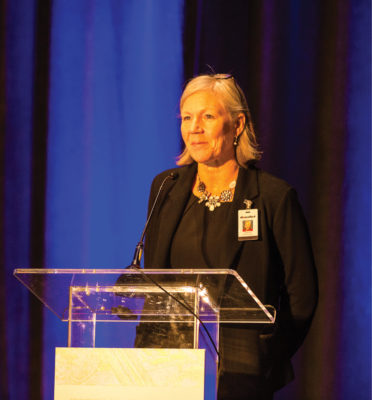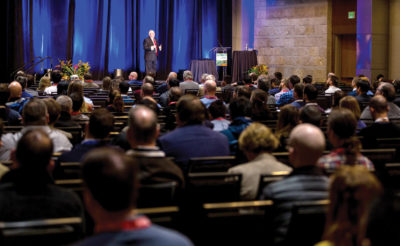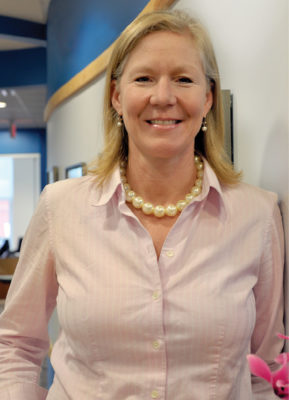
Lisa Murray, who left Diversified Communications on 15 January 2021 having masterminded the growth of the company’s geospatial events for many years.
Most readers of LIDAR Magazine have attended a Diversified Communications (DC) event, International LiDAR Mapping Forum (ILMF) being the best known. Many of us have had the privilege to spend time with DC’s Group Director, Lisa Murray. She not only directed the trade shows and conferences that we attended and enjoyed, but she was instrumental in creating the Lidar Leader Awards, a joint initiative of DC and LIDAR Magazine. On 22 December 2020, DC announced that Lisa would leave the company—her last day was 15 January 2021—for a new career in counseling. Since she has made such a difference to the events landscape in our geospatial world, LIDAR Magazine contacted Lisa before she left and she agreed to give this “exit interview”.
LIDAR: Lisa, it was with sadness that we learned of your decision to leave DC. You have made such a difference to the geospatial world. Although most of our readers are familiar with DC events, not so many know you as an individual. Can you please tell us something about yourself? When did you join DC and why? What has been your career path with the company? How does your geospatial brief fit into DC as a whole? DC seems to have more offices in the UK than the US, but it’s a US company, isn’t it?
Murray: DC is a third-generation privately-owned communications company based in Portland, Maine with offices in the UK, Australia and Hong Kong. DC produces over 120 events annually and a vast array of digital products for a range of industries worldwide. The full portfolio can be seen at divcom.com/portfolio-products-services.
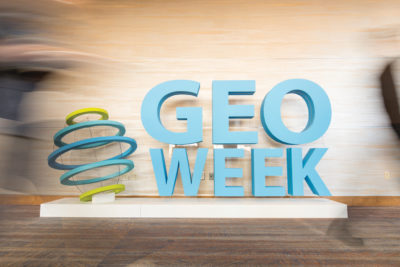
Artwork in support of Diversified Communications’ rebranding of Geo Week for 2022. Courtesy of Diversified Communications.
I joined DC in 1993 as a sales rep, brought in to help launch the European Seafood Exposition, which went on to become the world’s largest seafood show and DC’s largest event. After seven years on that product, I took three and a half years off to stay at home with my two young children. I was hired back to run an organic food and beverage show which DC had acquired and eventually sold. I then pivoted to manage sales for SPAR International, a laser scanning technology conference and expo acquired by DC in 2010. I eventually became event director for SPAR.
LIDAR: Prior to the pandemic, in-person events (at least those that you hosted) seemed to enjoy a renaissance, expanding both individually and as a group. What dynamics were at play here? Can you speak to what your exhibitors and attendees sought when attending your shows?
Murray: 2019 was a banner year of growth for the technology portfolio, but it started back in 2010 with the acquisition of SPAR. The vision was always to grow and acquire events with complementary technologies that could eventually come together as one larger, overarching event covering end-to-end precision measurement technologies across myriad industries. Our timing was good: in a market where “data is the new oil”, our customers were at the forefront of innovation, providing technologies critical to the new data economy. We saw an opportunity to integrate them but the market was not yet ready. Instead, we focused on strengthening each individual event.
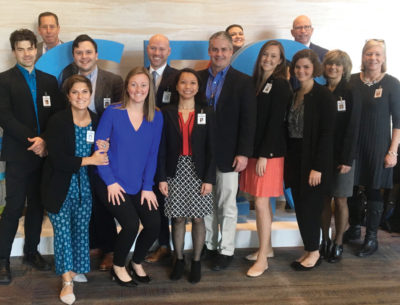
Diversified Communications’ event team captured at Geo Week in 2019. Lisa Murray is on the far right. Courtesy of Diversified Communications.
We listened carefully to our customers, who found a welcome platform in our tech events and digital channels to share knowledge and expand adoption. We focused on raising the quality and quantity of attendees to ensure we were delivering qualified leads and we researched additional exhibit categories to expand exhibits on offer in a way that made sense for the buyers. There was a concerted effort to refine our content, attracting compelling keynotes and next-gen content while barring sales pitches from the program. At every turn, we considered the attendee perspective, finding ways to attract more and better-quality attendees. When you do this, exhibit growth takes care of itself. Everyone wants to be where the buyers are; bellwethers expand their investment and new entrants to market join to get access to key decision makers. Again, it all comes down to having the right people in the room and then it grows from there.
LIDAR: Your experience with the “geotech” community is unparalleled in some respects. What have you learned about the various sectors that may not be apparent to the everyday “bystander”? Alternately, what is most memorable, looking back?
Murray: There is often a perception that vertically-integrated events (industry-specific) are better than horizontally-integrated events (multiple industry sectors converging around common technologies.) Our management team never bought into this. Our experience was the opposite—that there was much to be gained by attendees from various industries coming together at one event focused around a certain technology or technologies. I think it’s more intuitive for people to gravitate toward an industry event, be it focused on mining, transportation or any industry. What they miss, however, is a deep dive on new technology tools and the opportunity to see how other sectors are using the technology. Often the best connections and the most out-of-the-box thinking comes from horizontally oriented events where, for example, thousands of users of laser scanning technology solutions can gain broader insight as to how the technology is used universally rather than the potentially limited use unique to their sector.
LIDAR: You’ve brought several member organizations into the fold, such as ASPRS, GITA, MAPPS and USIBD. Is colocation a hard trend and, if so, what do you believe is driving this? What do you think about the future of professional events?
Murray: I remember being struck in the beginning by the fragmentation in the industry and the proliferation of small events. Vendors were frustrated that there was no one event they could go to that met all their needs. This was unlike any other industry in which I had worked. So, from the beginning, my goal was to bring groups together in a more collaborative way for the common purpose of promoting related technology solutions. It took over seven years from the start of those conversations to the colocation of ILMF, ASPRS and MAPPS in 2018. I think everyone was pleasantly surprised by the results and that success drove the growth from there.
Regarding the future of live events, one upside of not having events in 2020 is that people realized how much they missed them and the value of face-to-face interaction. As live events come back, I believe they will be even stronger. We are already seeing this yearning to return to and invest in events as we come back online with Commercial UAV Expo Americas, in September in Las Vegas, and Geo Week 2022, already well along in the sales process and taking place in Denver in February 2022.
LIDAR: Is there anything you’d have liked to accomplish that you weren’t able to? Is there something you believe could or should happen within the industry that hasn’t?
Murray: Absolutely. I wish I could have stayed on for the first colocation of Geo Week that includes the integration of SPAR 3D and AEC Next. This is the first time that stakeholders across the geospatial industry and the built environment will come together. In my opinion, this is the beginning of something big. I have total confidence in the tech team and our advisors to deliver an excellent event. I only wish I could be there to raise a glass to their success and to watch the event develop into the powerhouse I know it will be.
LIDAR: Please tell us something about your new career. How and why did you become interested in counseling? What are your goals for this next phase of your career?
Murray: Good question. To most, being a therapist probably seems really different from being an event director. I guess I have always been interested in human behavior and the way I approached our events was to form strong bonds with customers, listening to their needs, finding out where they think the market is headed and probing about what their biggest challenges were. That’s really not so different from being a therapist and helping someone figure out where they are, where they are going and what obstacles might be in their way.
LIDAR: Owing to the pandemic, 2020 was a terrible year for conferences and trade shows, with most face-to-face events being canceled or postponed—how did DC navigate the tumult? How did it change its business model to suit the circumstances? Did it survive the year without sustaining major damage?
Murray: It’s true that the events business was heavily impacted by the pandemic. Fortunately, DC had numerous online products in place. These channels enabled customers to stay connected to their audiences, launch new products and collect leads via webinars, reports, product spotlights, interviews and other online forums. Our editorial, sales and marketing teams pivoted quickly and served up an unprecedented amount of online content in 2020. This shift forced many companies to up their online game. Once they saw the results of their digital media efforts, they have continued to invest in 2021. This ramped up digital avenues quickly, but I think those channels are here to stay, even as DC returns to its core business of producing live events.
LIDAR: We mentioned ILMF at the beginning of this interview, but this is only one of a portfolio of events for which you were responsible. Can you please describe how this portfolio evolved?
Murray: The tech portfolio started with the acquisition of SPAR Point Group in 2010 from Tom Greaves, including the SPAR International event and the SPAR3D.com website. DC then acquired ILMF and European Lidar Mapping Forum (ELMF) from Intelligent Events in the UK, to further expand into the technology space. AEC Next was a DC launch, paired as a colocation with the SPAR3D Expo & Conference to build on the AEC sector in that space. The idea was to put them together for an overall “geospatial meets built world” event, but the market was not ready for that integration at the time. In an effort to listen to the market, we ran these events separately and instead focused on making each event stronger.
In 2014, our UK office launched GEO Business, an overararching geospatial event based in London that largely replaced the need for ELMF.
In 2015, our team launched Commercial UAV Expo Americas in response to customer requests for a dedicated drone show addressing the integration of drones into the precision measurement space. In 2017, we launched Commercial UAV Expo Europe to serve the unique needs of the European market and establish DC as a global platform for drone education and integration. In 2020, we announced a partnership with Amsterdam Drone Week to partner with Commercial UAV Expo Europe. The first instance of that event will be in January 2022. All the above developments came from listening closely to customers and what they wanted as well as spotting trends and staying close to technology developments.
Indeed, three commercial drone shows were launched in 2015 with the same vision of focusing on sUAS technology in North America (among many other drone shows all over the globe). DC acquired Drone World Expo from JD Events in 2018 and integrated it into Commercial UAV Expo Americas. Commercial UAV Expo has always been the leading drone event for commercial users and the cancellation of Interdrone in 2021 further solidifies UAV Expo’s bright prospects as drone leaders now have a single event on which to focus their energy and investment.
LIDAR: ILMF evolved to become colocated with ASPRS’s annual conference and, indeed, other organizations such as MAPPS joined in. Then you introduced the name Geo Week to encompass all these components. This year DC is rebranding Geo Week and you have big plans for 2022. Can you please tell us about this?
Murray: In the age of interconnected data, it is our exhibitors and attendees who are at the forefront, developing and integrating technologies that are changing our world. I think this event has a unique opportunity as the leading geospatial event in North America to become the go-to platform for information exchange of core precision measurement technologies across critical industry segments such as infrastructure, transportation, engineering, construction, and many others. I couldn’t put it better than the way DC’s current Event Director, Lee Corkhill stated: “The event represents a continuum, with individuals and organizations from all corners of industry at differing levels of adoption. Geo Week will support a future vision, in which professionals and organizations that understand the full spectrum of data needs, work processes, software integration, and standards in both geospatial and BIM will be tomorrow’s technology leaders.”
Lisa Murray, thank you very much indeed for these fascinating answers. You have made a substantial difference to the lidar world and it is clear that DC’s role is going to grow. Your new position will ensure that the imaginative, cooperative approach that you have taken, always with a view to growth, will continue. LIDAR Magazine wishes you every success in your new career as a counsellor.
